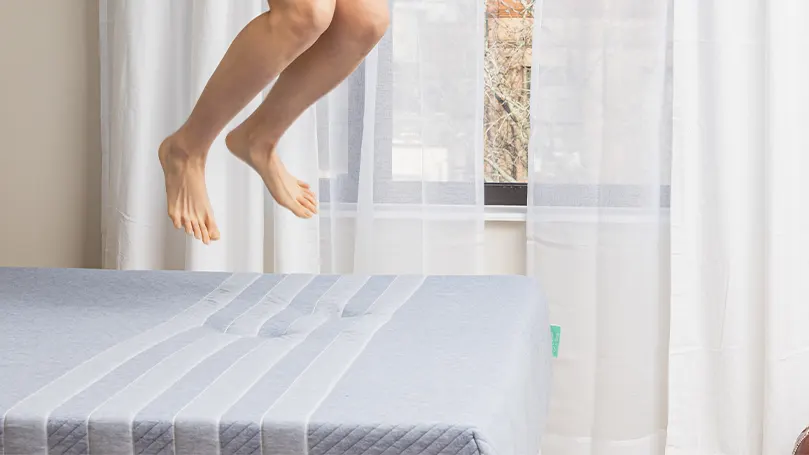How to know how much I should spend on a mattress?
There are many factors you should take into consideration when setting the budget for your new mattress. For example, how big should your new mattress be? Do you just want a Small Single or is a Queen size mattress necessary?
And does the new mattress have to check off specific boxes? For example, does it have to be an orthopaedic mattress or do you strictly want memory foam? Do you need a hypoallergenic environment or is that not necessary?
Yes, it might all seem a bit overwhelming at a glance. However, don't fret. The good news is that there is a mattress for every wallet, and we've put together a neat guide on how to arrive at your best spending amount.
Know your budget first

Start by mapping out an ideal budget – how much do you want to spend on a mattress? Would you be willing to increase your budget for a higher quality of sleep? If so, by how much? This should give you a rough ballpark of which mattresses are even worth considering. And after a bit of browsing, you should also get a fairly good idea of what mattresses in these price ranges tend to offer.
This is rather important as you don't want to fall into the trap of looking at luxury models and thinking that budget mattresses are all terrible. Sure, more money usually brings along more features, but there's not always a direct parallel between mattress cost and mattress quality.
So, instead of looking at every single mattress online, stick to your price range and try to develop a baseline for what constitutes a good mattress within your budget. This way you won't get overwhelmed and you can make an educated decision.
So, once you've gone through the tips below, think about how much you would need to spend on a mattress that would make you happy and tick most, if not all, of your checklist boxes. Use these ideas in tandem with your new knowledge and you should get the answer to “how much should I spend on a mattress?”.
Compare the different prices of different mattresses

Once you've achieved a general ballpark for your mattress budget, it's time to look at the individual products and see how they stack up against one another. By going through different sleeping brands, retailers, and models, you should pick up on the general level of quality that the price range entails.
And while a premium mattress is probably going to tick off more boxes than a cheap mattress, you'd be surprised with what you can find. A mattress that might not be that valuable to most people could be the perfect option for you. Or you might catch a sale that knocks the mattress price down comfortably into your budget.
You can also spend less with Emma Bundle and get more for less!
So, keep an eye out and compare as many mattresses that are within your budget as you can. It's also rather helpful to read mattress reviews or even take a mattress quiz in order to know what specific features you might want to look out for.
Get familiar with the different mattress types

By this point, you've hopefully determined which mattress size is ideal for you. And if not, feel free to check out our mattress size guide for more information.
The second question you need to ask yourself is “what mattress type would suit me the best?”. There are three broad categories to choose from – foam mattresses, pocket-sprung mattresses, and hybrid mattresses.
You could potentially also look into water mattresses and air mattresses, but since they're rare, we'll focus on the first three.
If comfort is your main concern when sleeping, a memory foam mattress will do you the most good. They generally offer a very cosy sleeping experience where you basically sink into the mattress. Plus, foam mattresses generally have good motion isolation, so if you share the bed, this is quite a decent selling point.
Firmer Mattresses
On the other hand, a pocket-sprung mattress isn't always as soft and comfortable, but usually offers much more support and stability. Pocket springs also generally lead to a firmer mattress, which is quite important for stomach sleepers or people with joint/back issues. Plus, they're usually quite bouncy and offer superior temperature regulation compared to foam mattresses, both of which are excellent perks if you sleep hot or share the bed.
Lastly, you have hybrid beds. Since these models utilise both foam and pocket springs, they're the middle ground between the two previous types. And while they're not as breathable as pocket spring mattresses, or as soft as pure-foam mattresses, they make for a very safe choice overall.
Of course, all of these are generalisations and don't apply to each and every model. So, in order to find a quality mattress, you need to take what we said as a general guideline, and do some further research from there.
And if you're looking for where to start, we have a few articles that will help you get a rough idea of what you're looking for. These are our favourite memory foam mattresses, these are our favourite pocket sprung mattresses, and these are our picks for the best hybrid mattresses.
Identify your sleep problems

Are you having back pain? Do you feel like you're falling into a dip in your current mattress, no matter how much you move away from it? Is your firm mattress giving you phantom bruises? Is your mattress too big for your bed frame?
Being aware of your current sleep problems means you won't make the same mistakes twice, and it should help you home in on the right mattress type for you.
So, try compiling a list of any and all issues that you're currently having with your mattress, and seek out ways to improve them.
For example, if your Single-size mattress had you constantly falling off the bed, look for a Double mattress this time around. If cheap mattresses from a certain brand always leave you feeling sore in the morning, try looking at other sleeping brands. And so on.
After all, a lower-quality mattress can significantly affect your sleep quality and overall health. So, make sure that whatever sleeping problems you currently have stay in the past with your old mattress.
Define your sleeping position

Another aspect people tend to overlook when getting a new bed is their sleeping position. It might seem arbitrary at first glance, but some mattresses are better suited for certain sleeping positions.
If you're a side sleeper, you'd want a relatively soft mattress. Since your hip and shoulder take on your weight during the night, the last thing you want is to have them pressed up against a hard surface.
It also helps to find a mattress with pain relief or zoned support for this very same reason.
If you're a back sleeper, a medium-firm mattress should suit your needs. And while not as essential, zoned support and pain relief are still very nice features you should look out for.
Stomach sleepers arguably need to be paying the most attention. This is because most sleeping brands tailor to side and back sleepers. So, getting the best mattress for yourself is a bit more difficult. In particular, you need to seek out a mattress that's on the firmer side of things, which mostly eliminates memory foam mattresses.
And if you're a combination sleeper, lean on your previous experience. With your previous mattress, how comfortable were you? And which position do you frequent the most? From there, just use the tips we've already mentioned.
Consider some cool features
Some higher-quality mattresses can offer you extra features that you won't find with every model. Natural materials, like bamboo are always a good choice for many reasons. Panda's Hybrid Bamboo mattress should be considered as one of the best in this category, especially as it comes from the acknowledged UK brand. So, if your budget allows it, take a look at these features and decide for yourself whether they're worth the extra money.
For example, more expensive mattresses can sometimes have vents on the sides, which boost breathability and helps regulate body heat. Or you could look into Dual core mattresses, where you can independently adjust the firmness level of both sides of the mattress – which is a blessing if you share the bed.
These features don't automatically make these mattresses the best mattresses on the market, but they do add some value. So, if you find mattresses with unique features that are still at an affordable price, why not spoil yourself a bit?
Take into consideration the warranty & trial period
Most mattress companies offer trial periods ranging from 30 days up to one year, during which time you can still return your product. While we hope you find your perfect match for a good night's sleep from the get-go, trials and warranty schemes can alleviate the stress of deciding on the right mattress to buy.
So, it's always a smart idea to look around and see whether you can find a mattress with good coverage. And trust us, it's more than worth it to look into this stuff – as it can make the difference between getting no warranty whatsoever and a lifetime warranty.
So, even if you have to pay a bit more, we always advise you to go for the mattress with better coverage in terms of the trial and the warranty. After all, what's the point of saving a few pounds if you live in constant fear that the mattress might deteriorate within a week?
The mattresses’ price ranges

Navigating mattress prices can seem overwhelming.
On the one hand, a cheap mattress saves up on cash, but it might not offer your spine the optimal support it needs, leading to back pain and more frustration over time.
On the other hand, building a great and supportive bed can reach thousands of pounds if you go all out. Which price category should your new mattress be in? Let's break them down.
<£500
If you're on a tight budget, it is possible to avoid buying a low-quality mattress, as long as you do some prior research. Most mattresses in this category will be made of synthetic materials. You may find mattresses with good quality pocket springs or basic memory foam – but beware of thin foam, as it can easily sag.
£500 – £1000
A great mattress in this price range will likely have an extended warranty and spare you the need for a mattress topper. These average-priced mattresses should offer good pressure relief, protecting your body from body aches regardless of your preferred sleeping position. Memory foam mattresses should have a higher density, and you may start finding synthetic materials of higher quality, like latex, around the latter price point. Ideally, mattresses in this price range will also be over 25cm deep.
And the closer you get to that £1000 price point, the more your expectations should rise. You will likely have a choice of natural fibres such as 500gsm wool and extra comfort layers; good latex and hybrid mattresses may also fall within this price category.
£2000 – £5000
If you're on the lookout for luxury, you can hunt for your perfect mattress here: the options of hybrid mattresses and the mix of materials are plenty, and you can treat specific areas of pain in your body through your choice of mattress.
This is also where you'll start seeing very unique features like lifetime warranties, side vents, and handmade designs. And if luxury is your cup of tea, we recommend giving our luxury mattress list a look.
£5000 +
A bed fit for royalty! This price category can get you the best-quality king-size mattress with gel memory foam, micro-coils, and 900gsm wool. These extra options should give you the most comfortable experience: no pain and excellent quality of sleep wrapped up in a durable mattress.
These mattresses can also often be customised – so the manufacturer can tailor the mattress to be a perfect fit for just you. Then again, with a price point this high, it only stands to reason that you're getting the very best the industry has to offer.
How to not overspend money on a new mattress?
Overspending is a matter of both your initial budget and the quality of your purchase. Hence, the key to not overspending is having realistic expectations, and making an informed purchase. Research what your mattress store offers, and what others think about your options, and choose the best fit for you. Based on your initial budget, think about the criteria you would be willing to compromise on, versus the comfort you would definitely not want to give up.
What is better: spring or memory foam in terms of longevity?

Lastly, let's talk about durability – as it dictates how soon you'll have to return to this article and go through the entire buying process once more.
Experts at the Better Sleep Council recommend switching out your mattress every 7 years, however, this can vary.
So, if you want a more detailed explanation, feel free to read our article on the topic of when a mattress needs to be replaced.
Choosing a good mattress composition can help you get the most out of your money – as high-quality materials will greatly increase the lifespan of your next mattress, regardless of whether it is made of foam or coil springs.
But if we're not taking material quality into account, these are the general rules when it comes to the pocket spring vs memory foam debate. On average, pocket-sprung mattresses will last you longer than memory foam models. This is because they're usually sturdier and have better breathability.
However, if you're on the heavier side or if you have a habit of jumping onto the bed, a memory foam mattress might be better in the long run. This is because the springs will get worn out more quickly, leading to a lumpy and disappointing mattress.
If all else fails, you can always just go for a hybrid mattress and play things safe. And if you still can't make a decision and pick the perfect mattress, we suggest you read our in-depth guide on choosing the perfect mattress.
Conclusion
So, how much should I spend on a mattress? Well, it depends on exactly what you're looking for! And we hope that now you have a good understanding of what different price points bring to the table. But if you do still have any questions, feel free to leave them in the comments.
Spread the word
Related products:














There are no comments yet
"*" indicates required fields